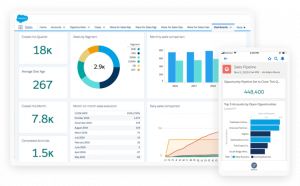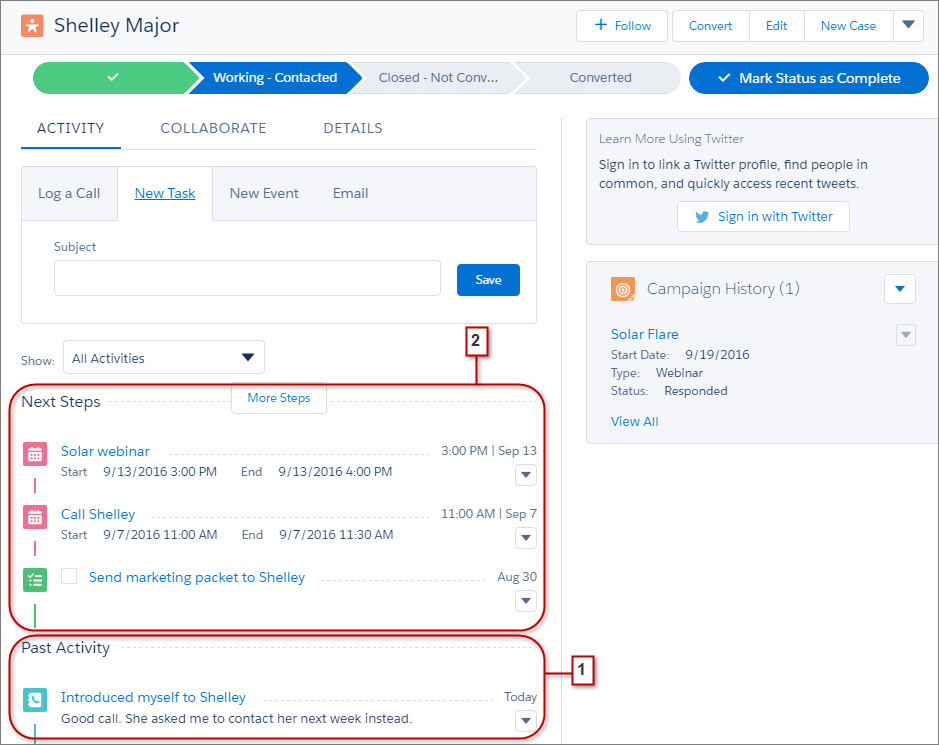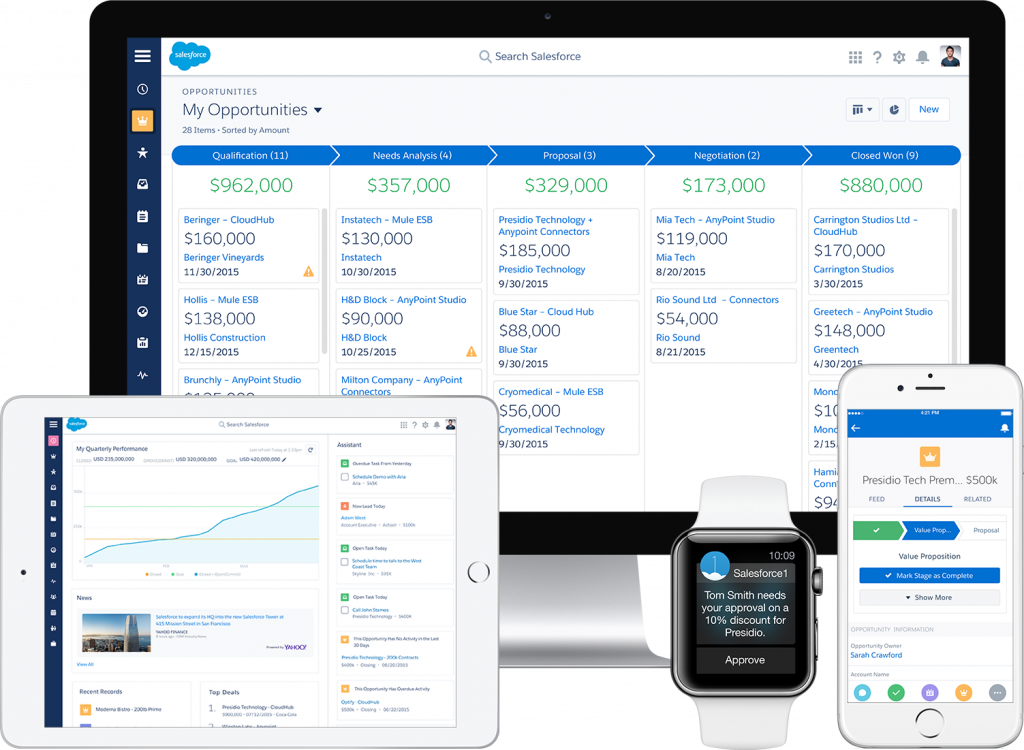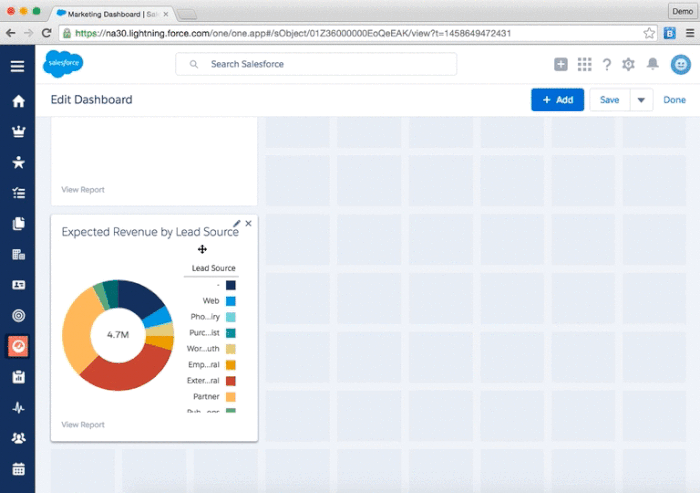In times of crisis, as we are living now, it is critical to find new strategies to get more leads, maintain our Client’s loyalty and increase productivity amongst our team. And as you can see from the title of this post, I believe that a CRM can help tremendously in these challenging times.
If you are still confused by this buzzy acronym, CRM stands for “Customer Relationship Management”. In essence, it is a software application that manages critical customer data, centralized in a single location. In this type of app, you can view customer info, send emails, track sales progress, and even follow your lead on social media. Cool, huh?
What is Salesforce Sales Cloud?
Sales Cloud is a cloud-based CRM from Salesforce. It includes tools for all the mentioned purposes and more: contact management, sales force automation, sales forecasting, and productivity. It allows sales teams and executives to manage the sales cycle, prioritize tasks, manage customer relationships, and access meaningful data about your business and competition.
is a cloud-based CRM from Salesforce. It includes tools for all the mentioned purposes and more: contact management, sales force automation, sales forecasting, and productivity. It allows sales teams and executives to manage the sales cycle, prioritize tasks, manage customer relationships, and access meaningful data about your business and competition.
This system can benefit companies of any size, both B2C and B2B. Because Sales Cloud is a software as a service (SaaS) model, companies no longer need to deal with what on-premise apps demands, like servers, software issues, and new version upgrades. This allows companies to lower up-front costs, quick setup and deployment, easy upgrades, and still achieve scalability as the business grow.
A solid CRM strategy is crucial to the success of the companies’ competitiveness. With it, companies can shift their focus on to their core business instead of sales and customer relations manual processes. So, let us explore Sales Cloud features that can help you close deals, accelerate productivity, and make insightful decisions — from anywhere.
Close more deals
No matter the size of a company, industry, or geography, we all share one common goal: have a growing, successful business. That’s why we need to build a structure to help managers and sales reps to do their best job, with the best technology available.
And we all know that contact management with spreadsheets can go south in a blink of an eye. These days, the competition is fierce and to be in the right time at the right place; we need to have a web-based account management software that delivers a 360-degree view of our customers, including activity history, customer communications, internal account discussions, and even gaining insights from popular social media sites such as Facebook, Twitter, and LinkedIn — right within Sales Cloud.
Once we have a unified and complete view of contacts, it’s time to identify some potential clients. But how can we optimize this process to close more deals? By streamlining sales process with Sales Cloud opportunity management system.
This pipeline management gives a detailed, complete view of the most important deals — from deal value to competition — so we can make the right moves at the right time. Here we can check sales stage, products, competition, and more.
And if you want to make this process even faster, you can create workflows and approvals processes to automate manual tasks like filling out orders or putting together complex proposals. You can also create automatic email alerts for deals over a certain size, auto-assign tasks as a deal moves through the different stages, and more.
Accelerates Productivity
The last example was a clear demonstration of what Sales Cloud can do for your productivity’s team. But there are many other examples. Let’s dive deeper:
Mobile: Salesforce has made a huge investment in portability. A salesperson should have the autonomy to log calls, respond to leads, track opportunities, and update data from anywhere and at any time, right from their smartphone or tablet!

Workflow and Approval: With a simple drag-and-drop you can build automated business processes. This feature is highly scalable and customizable to complex business demands.
Customizable dashboards: Each member of your sales team can have their own dashboards to improve their day-to-day tasks. They can have a highlight of their work and goal while the manager has a unified view of the entire team.
Email integration: Sales Cloud can be seamlessly integrated with your favorite email suite. You can sync contacts, events, and tasks between your email and Salesforce. Like so, you can track every email activity from a contact, without manual logging in.
Lead Generation: Web-to-Lead is the process of using a website form to capture visitor information and store that information as a new lead in Salesforce. They can be part of Campaigns and have auto-response rules.
Files Sync and Share: We all want easy and safe access to files, right? Sales Cloud has that too. Not only it’s simple to share and discuss a file, you are able to track and notify your team in real-time every time something is published or updated.
Make insightful decisions
When you don’t have a powerful system behind your business, it’s harder to make fast and critical decisions. By easily tracking lead volumes, conversion rates, and every part of your pipeline in real-time, you view all the state of your business, allowing you to make smarter decisions, from anywhere.

And say goodbye to “Joe”, from IT, you no longer need him to build reports! Sales Cloud analytics software keeps you updated with customized sales forecasting reports that you can build with ease. Just drag and drop the fields, filters, groupings, and charts that you want, and get an immediate real-time view at a glance. Easy-peasy!
Sales Cloud, Service Cloud… What?!
If you’ve been randomly searching for information about Salesforce products, I’m sure you’ve come across Service Cloud.
Confused? No worries let me explain: Sales Cloud was built to help salespeople to sell smarter and faster. While the Service Cloud helps companies to run and improve their customer service. It totally depends on your business requirements, which cloud features fit best.
How to get even more out of Sales Cloud
Ok, now that you made the right move towards high-efficiency sales and master the basics of Sales Cloud, we are ready to take the next step. What if you could get even more value from this top-notch system? Let me show you:
Enhanced customization
It’s obvious that quick and flexible customization to any business is one of the main features that attracts companies to this solution. And there’s much more than meets the eye.
Every business has their unique needs and requirements. That is why Sales Cloud offers enhanced customization so you can develop fine-tuned apps, profiles, and page layouts perfect for how you do business. You can also build strong permissions and record sharing rules, using Roles and Sharing Rules features to mirror your Company Sales structure and hierarchy. This way you can set up levels of accessibility to records and reports.

One of the most important features to remember is that almost anything can be adjusted to fit how you do business. From field to security requirements, everything can be tweaked to your needs. So, take advantage of that! Tailor your Sales Cloud to your company’s needs. Create your own objects, create your own apps! The options are as limited as your imagination. ?
Automate, automate, automate
Automation is another key reason why companies make the investment in a CRM. As we discussed before, there are many tasks that can be automated. Simple tasks such as contact, and opportunities management will save your sales team a lot of time to do what they do best: sell.
But we can go even further.
One great feature of Sales Cloud is creating quotes incredibly fast. By tracking which products are part of your deal, including quantity, standard price, quoted price, and product codes, you can automatically populate a quote with relevant customer data, generate a PDF from an approved template, and email it to customers directly from Salesforce in just a few clicks. Awesome, right?!
These types of workflow in a sales approval process, will not only save you a lot of time but also give consistency. The accuracy level of your sales documents, such as invoices, sales requests, and discounts will be on par with the company standards as they are reviewed by multiple decision-makers. Ultimately, it will remove a lot of bottlenecks that manual approvals can make, allowing the sales team to focus on new leads.
Connect and Integrate
Let’s assume that you are a manager or a sales rep. It’s 9 am and you sit in front of the computer. Now envision: how many applications do you need to open to do your daily work? Two, four, ten? You probably need to check your commission status, search for new leads, view contact info, all this over email and a prehistoric ERP. You do you imagine how hard to manage all of this? Not only we have dispersed data, we are storing this information in multiple places.
But let’s face it. We cannot just stop using those applications. The way Salesforce found to facilitate our work was to make Sales Cloud (and almost all Salesforce products) easy to integrate with other systems. By connecting them, you only need access to one system to see the complete picture of your customers.
This is possible because of Salesforce Application Program Interfaces (APIs). They are simple, powerful, and secure. And if you’re looking for something new, you can also find the perfect fit for your sales needs from partner apps. Check out AppExchange for hundreds of apps ready for you to use right out of the box!
What is Pardot? Marketing Automation made simple and smarterWe know that businesses aren’t static. They change and evolve according to market demands. Therefore, the system needs to be prepared for those changes. Anytime a sales rep wants to change a workflow or put in new customizations, we don’t want disruption of the system. Rather than developing and test in Production Org, sandboxes are a great solution. This is a safe testing ground, to help you make those much-needed tweaks that allows efficiency and innovation.
A game-changing way of doing business
From a sales rep perspective, Sales Cloud helps decrease redundancies, optimize processes, prioritize actions, communicate better, and access information to close more deals. Managers benefit from features that give a unified view of history and status, and tools to design efficiency-boosting workflows and approval processes. And for those in leadership, with the help of dashboards, analysis, and forecasting tools, they will be able to make insightful and fast decisions.
As you can see, the success of an organization results from all the accumulated decisions made by all parties. The purpose of Sales Cloud is to not only make lives easier but make them work seamlessly together.
Pro-tip: The most successful salespeople don’t rely on luck. Learn more about the the winning routines that help them consistently close deals. Check out the 8 Tips To Upgrade Your Routine.
Here, at Near Partner, we love Sales Cloud. How does your company manage the relationship with your client? Are you still on Excel spreadsheets or working with another system? We want to know everything!
__________________________






